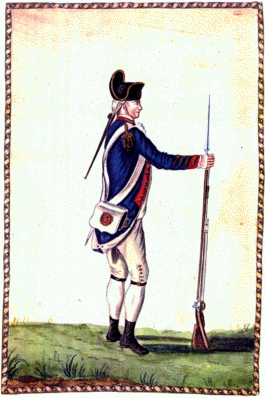


Iralnde 1794 Royal Irish Artillery Londres
English Translation
 |
Historique Voir ICI
History Click HERE
The story of the Royal Irish Artillery from its formation in 1756 to 1801 when it was absorbed into the Royal Artillery with the main emphasis on regimental details including nominal rolls of officers, strength returns, pay and dress details.
In 1687 a Royal Warrant was issued for the establishment of an Office of Ordnance and Train of Artillery in Ireland, which had a staff of only 40 distributed among several garrisons, but Ireland lacked its own specialist Artillery Corps. Furthermore, down to 1755 no Irishman whatsoever was allowed to be enlisted for the Army serving in Ireland - a consequence of the Test Act of 1673, directed against Catholics which, among other things, permitted recruiting for the Army on the Irish Establishment only from English Protestants.
In February 1756 this was amended to include Protestants from the Province of Ulster. On 1 April 1756 the Train of Artillery was expanded to a company and further increased in 1760 to four companies and designated a regiment with the full title The Royal Irish Regiment of Artillery with the Earl of Kildare as its first Colonel in Chief.
By 1800 the Royal Irish Artillery had reached its high point of twenty Marching Companies and an Invalid Company with a total strength of 2,132 men.
After the Act of Union in 1801 the regiment was absorbed into the Royal Regiment of Artillery as the 7th Battalion RA. During its forty years as an independent regiment the Royal Irish Artillery saw its fair share of action, either as a unit or in supplying volunteers to the Royal Artillery units overseas.
Volunteers fought in RA batteries during the American War of Independence; they were in action in Flanders in 1794 and in the West Indies in 1795 when yellow fever killed more than the French: out of 11 officers and 288 other ranks only 4 officers and 43 men survived. Back home they were engaged in several engagements in the Irish Rebellion of 1798. But the main focus of the book is on domestic aspects, and to this end there are numerous tables giving strength returns, establishment details, pay, recruiting figures and dress.
There is the succession of Colonels, the roll of officers who entered the Royal Irish Artillery from 1756 to 1801, giving dates of entry and rank, the rank attained afterwards, dates of retirement or leaving the Regiment or death; and finally there is the list of officers who transferred to the Royal Artillery in April 1801 with details of their service.